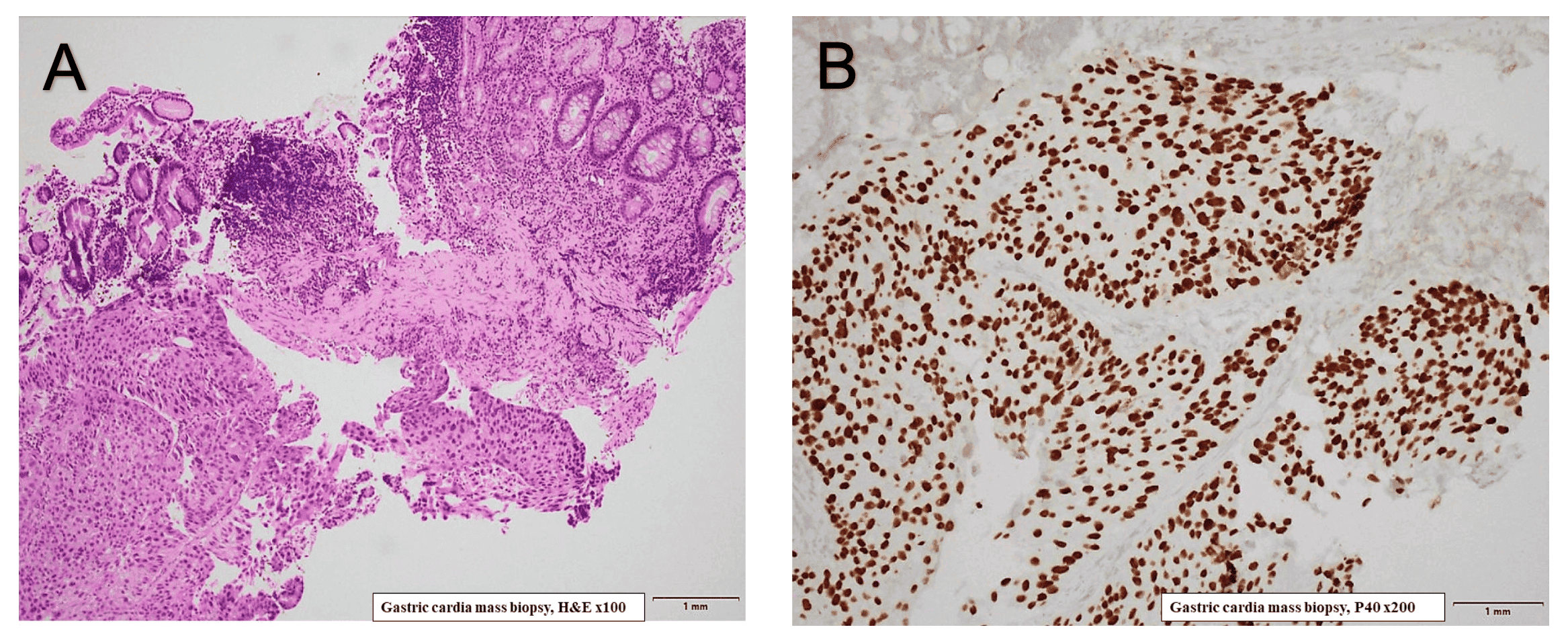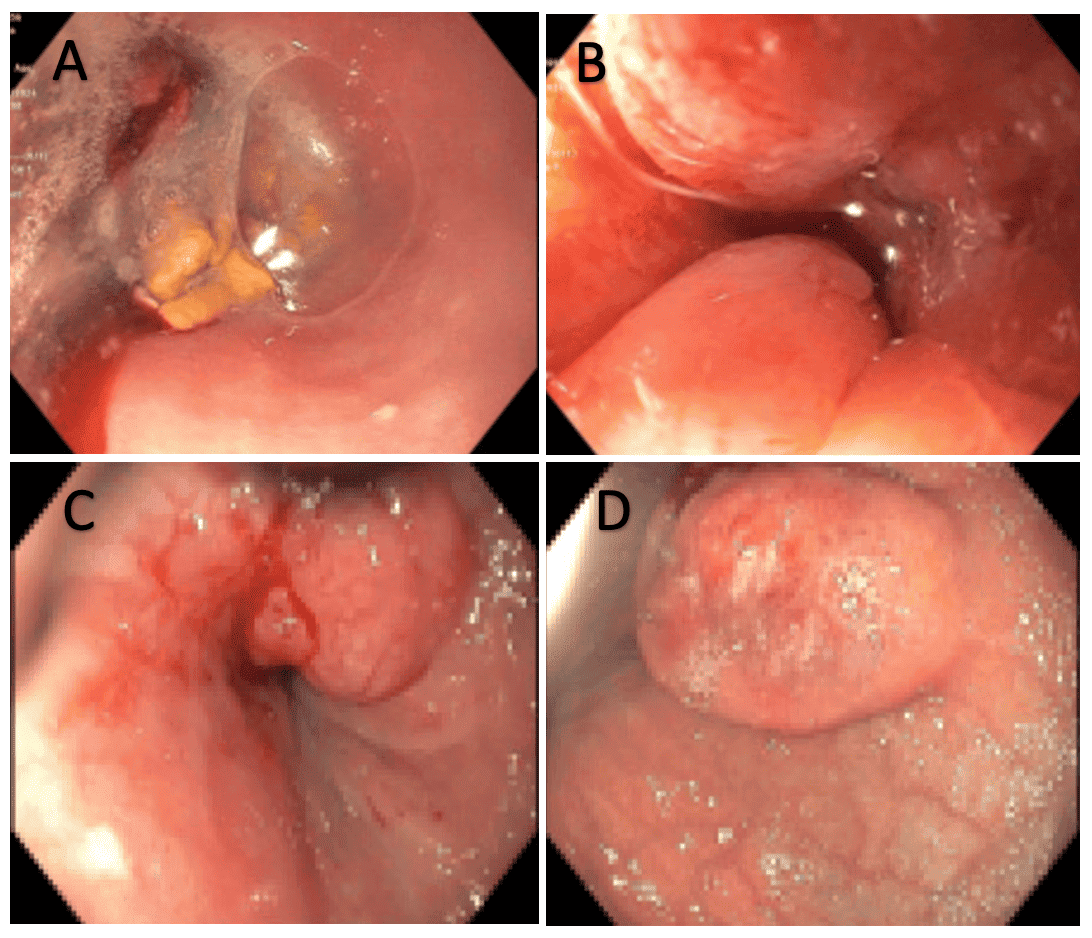Sunday Poster Session
Category: Stomach and Spleen
P2089 - A Rare Co-occurrence of Squamous Cell Carcinoma of the Stomach and Gastroesophageal Junction With Positive Immunohistochemistry: Primary or Metastatic?
Sunday, October 26, 2025
3:30 PM - 7:00 PM PDT
Location: Exhibit Hall

Maureen Okafor, MD, MPH
NYC Health + Hospitals/South Brooklyn Health
Brooklyn, NY
Presenting Author(s)
Maureen Okafor, MD, MPH, Mark Anthony Fallorina, MD, Nikisha Pandya, MD, Joshua Diaz, MD, Yun Deng, MD, Vera Platsky, MD, Muhammad Abdullah, MD
NYC Health + Hospitals/South Brooklyn Health, Brooklyn, NY
Introduction: Primary gastric squamous cell carcinoma (GSCC) is an extremely rare malignancy with unclear standards of care due to a typically late diagnosis and poor prognosis. While GSCC are uncommon, esophageal cancers are more prevalently of squamous cell type. With few reported cases in literature, the co-occurrence of GSCC and esophageal squamous cell cancers (ESCC), diagnosis, targeted therapies, and prognosis remain to be fully understood.
Case Description/
Methods: A 51-year-old male with a 35-year active smoking history presented to the ED with dysphagia, odynophagia to solids and liquids, epigastric pain, nausea and vomiting. He denied fever, alcohol use and weight loss. Clinical findings of epigastric tenderness and iron deficiency anemia were present. CT abdomen showed a distal esophageal and gastric fundus thickening. An urgent EGD revealed LA Grade D esophagitis, narrowing of the distal esophageal lumen with marked cardia edema and inflammation. He was started on a proton pump inhibitor with a plan to return in 4 weeks for a repeat EGD when inflammatory changes and risk for perforation would have diminished. Six weeks later, he returned cachectic with progressive worsening of prior symptoms. Repeat CT abdomen showed a distal esophageal thickening, gastric fundus mass (5.4 x 4.0 x 4.6 cm) and no lymphadenopathy. EGD demonstrated LA Grade B distal esophagitis, a gastroesophageal (GEJ) mass and a large ulcerated non-bleeding gastric cardia mass. Histology confirmed a moderately differentiated squamous cell carcinoma, inactive gastritis and intestinal metaplasia. Immunohistochemistry (IHC) was p40 positive and negative for PD-L1, mucicarmine and H. pylori. A multidisciplinary team opted for PET/CT staging and neoadjuvant chemoradiotherapy. He then received a feeding jejunostomy tube with partial esophagogastrectomy.
Discussion: As in this unique case, a clinical dilemma arises when SCC appears synchronously in the GEJ and stomach. Although a primary GSCC in the cardia less likely presents with an ESCC, this event is not absolutely discounted. While ESCC is more common overall, it is less frequent at the GEJ compared to adenocarcinomas. IHC confirmed both tumors to be primary SCC but could not determine if they were either synchronous, a primary GSCC with extension to the GEJ or vice versa. While primary GSCC and ESCC follow established protocols for other squamous cell cancers, further investigation of this rare clinical entity may improve early diagnosis and ultimately, therapeutic best practices.

Figure: Figure 1. Initial esophagogastroduodenoscopy images (A, B) demonstrating poor visualization of the lower esophagus with significant food debris (A), LA Grade D lower esophagitis with marked edema and inflammation of the gastroesophageal junction and gastric cardia (B). Images of the second esophagogastroduodenoscopy (C, D) show a hiatal hernia, a medium-sized non-bleeding non-obstructing gastroesophageal mass (C), and large ulcerated non-bleeding gastric cardia mass (C).

Figure: Figure 2. Immunohistochemical expression of moderately differentiated squamous cells and intestinal metaplasia of gastric cardia mass on H&E stain (A), and exhibition of positivity for p40 biomarker (B), indicating squamous cell carcinoma.
Disclosures:
Maureen Okafor indicated no relevant financial relationships.
Mark Anthony Fallorina indicated no relevant financial relationships.
Nikisha Pandya indicated no relevant financial relationships.
Joshua Diaz indicated no relevant financial relationships.
Yun Deng indicated no relevant financial relationships.
Vera Platsky indicated no relevant financial relationships.
Muhammad Abdullah indicated no relevant financial relationships.
Maureen Okafor, MD, MPH, Mark Anthony Fallorina, MD, Nikisha Pandya, MD, Joshua Diaz, MD, Yun Deng, MD, Vera Platsky, MD, Muhammad Abdullah, MD. P2089 - A Rare Co-occurrence of Squamous Cell Carcinoma of the Stomach and Gastroesophageal Junction With Positive Immunohistochemistry: Primary or Metastatic?, ACG 2025 Annual Scientific Meeting Abstracts. Phoenix, AZ: American College of Gastroenterology.
NYC Health + Hospitals/South Brooklyn Health, Brooklyn, NY
Introduction: Primary gastric squamous cell carcinoma (GSCC) is an extremely rare malignancy with unclear standards of care due to a typically late diagnosis and poor prognosis. While GSCC are uncommon, esophageal cancers are more prevalently of squamous cell type. With few reported cases in literature, the co-occurrence of GSCC and esophageal squamous cell cancers (ESCC), diagnosis, targeted therapies, and prognosis remain to be fully understood.
Case Description/
Methods: A 51-year-old male with a 35-year active smoking history presented to the ED with dysphagia, odynophagia to solids and liquids, epigastric pain, nausea and vomiting. He denied fever, alcohol use and weight loss. Clinical findings of epigastric tenderness and iron deficiency anemia were present. CT abdomen showed a distal esophageal and gastric fundus thickening. An urgent EGD revealed LA Grade D esophagitis, narrowing of the distal esophageal lumen with marked cardia edema and inflammation. He was started on a proton pump inhibitor with a plan to return in 4 weeks for a repeat EGD when inflammatory changes and risk for perforation would have diminished. Six weeks later, he returned cachectic with progressive worsening of prior symptoms. Repeat CT abdomen showed a distal esophageal thickening, gastric fundus mass (5.4 x 4.0 x 4.6 cm) and no lymphadenopathy. EGD demonstrated LA Grade B distal esophagitis, a gastroesophageal (GEJ) mass and a large ulcerated non-bleeding gastric cardia mass. Histology confirmed a moderately differentiated squamous cell carcinoma, inactive gastritis and intestinal metaplasia. Immunohistochemistry (IHC) was p40 positive and negative for PD-L1, mucicarmine and H. pylori. A multidisciplinary team opted for PET/CT staging and neoadjuvant chemoradiotherapy. He then received a feeding jejunostomy tube with partial esophagogastrectomy.
Discussion: As in this unique case, a clinical dilemma arises when SCC appears synchronously in the GEJ and stomach. Although a primary GSCC in the cardia less likely presents with an ESCC, this event is not absolutely discounted. While ESCC is more common overall, it is less frequent at the GEJ compared to adenocarcinomas. IHC confirmed both tumors to be primary SCC but could not determine if they were either synchronous, a primary GSCC with extension to the GEJ or vice versa. While primary GSCC and ESCC follow established protocols for other squamous cell cancers, further investigation of this rare clinical entity may improve early diagnosis and ultimately, therapeutic best practices.

Figure: Figure 1. Initial esophagogastroduodenoscopy images (A, B) demonstrating poor visualization of the lower esophagus with significant food debris (A), LA Grade D lower esophagitis with marked edema and inflammation of the gastroesophageal junction and gastric cardia (B). Images of the second esophagogastroduodenoscopy (C, D) show a hiatal hernia, a medium-sized non-bleeding non-obstructing gastroesophageal mass (C), and large ulcerated non-bleeding gastric cardia mass (C).

Figure: Figure 2. Immunohistochemical expression of moderately differentiated squamous cells and intestinal metaplasia of gastric cardia mass on H&E stain (A), and exhibition of positivity for p40 biomarker (B), indicating squamous cell carcinoma.
Disclosures:
Maureen Okafor indicated no relevant financial relationships.
Mark Anthony Fallorina indicated no relevant financial relationships.
Nikisha Pandya indicated no relevant financial relationships.
Joshua Diaz indicated no relevant financial relationships.
Yun Deng indicated no relevant financial relationships.
Vera Platsky indicated no relevant financial relationships.
Muhammad Abdullah indicated no relevant financial relationships.
Maureen Okafor, MD, MPH, Mark Anthony Fallorina, MD, Nikisha Pandya, MD, Joshua Diaz, MD, Yun Deng, MD, Vera Platsky, MD, Muhammad Abdullah, MD. P2089 - A Rare Co-occurrence of Squamous Cell Carcinoma of the Stomach and Gastroesophageal Junction With Positive Immunohistochemistry: Primary or Metastatic?, ACG 2025 Annual Scientific Meeting Abstracts. Phoenix, AZ: American College of Gastroenterology.

